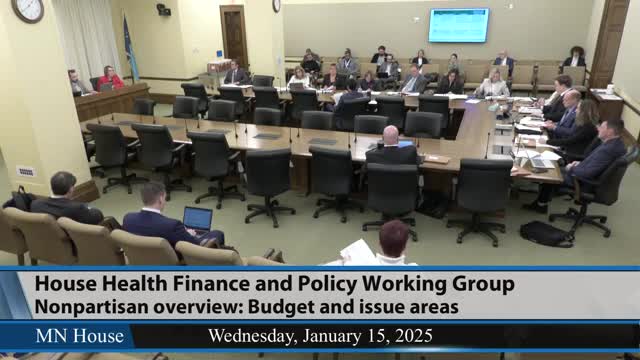Staff outlines Medical Assistance and MinnesotaCare enrollment, benefits and financing
January 15, 2025 | 2025 Legislature MN, Minnesota
This article was created by AI summarizing key points discussed. AI makes mistakes, so for full details and context, please refer to the video of the full meeting. Please report any errors so we can fix them. Report an error »

House Research staff provided an overview of Medical Assistance (MA) and MinnesotaCare to the House Health Finance and Policy Work Group on Jan. 15, outlining enrollment, eligibility rules, delivery models and financing.
Why it matters: MA and MinnesotaCare together form the subsidized coverage safety net for low-income Minnesotans; enrollment levels, benefit design and financing mechanics determine state and federal spending obligations.
Annie Mok of House Research explained that Medical Assistance is Minnesota’s Medicaid program and that about 1,000,000 people are enrolled each month. She said MA is an entitlement program jointly financed by state and federal dollars; federal matching (the FMAP) is determined by law. Mok said most MA enrollees — roughly 63% — are parents and children; about 22% are adults without children and about 6% of enrollees are 65 or older. Staff noted that, by spending, a disproportionate share goes to people with disabilities: the presentation reported that about 40% of MA spending is on the roughly 9% of enrollees who have disabilities.
Mok described how most MA enrollees are served in managed-care systems (about 75% of enrollees), with county-based purchasing plans and HMOs receiving capitated payments from the Department of Human Services and then negotiating provider rates. Fee-for-service coverage remains available and is used more often by some people with disabilities.
On MinnesotaCare, Mok said the program is a state-run Basic Health Program established under the Affordable Care Act and that about 100,000 people are enrolled each month. MinnesotaCare eligibility requires Minnesota residency, lack of access to other coverage and income between about 133% and 200% of the federal poverty level; as of Jan. 1 the program no longer has a citizenship requirement mentioned in earlier years. Many MinnesotaCare enrollees are enrolled in managed-care organizations; MinnesotaCare must offer at least two MCO choices in each county.
Mok also described premium and cost-sharing rules: MA has no premiums and — as of Jan. 1 of the prior year — no cost sharing; MinnesotaCare charges sliding-scale premiums only for enrollees aged 21 and older, ranging currently from $0 to $28 and set to expand to a range up to $80 in 2026 under federal rules tied to premium tax credits. She noted the federal premium tax-credit increases that affect allowable BHP premiums are scheduled to expire at the end of 2025, which would change the allowable premium range.
MNsure, the state’s health insurance exchange, administers eligibility for premium tax credits and cost-sharing reductions, and Minnesotans can apply for MA and MinnesotaCare through MNsure, staff said.
The presentation was informational; the committee did not take formal action on benefits or eligibility during the meeting.
Why it matters: MA and MinnesotaCare together form the subsidized coverage safety net for low-income Minnesotans; enrollment levels, benefit design and financing mechanics determine state and federal spending obligations.
Annie Mok of House Research explained that Medical Assistance is Minnesota’s Medicaid program and that about 1,000,000 people are enrolled each month. She said MA is an entitlement program jointly financed by state and federal dollars; federal matching (the FMAP) is determined by law. Mok said most MA enrollees — roughly 63% — are parents and children; about 22% are adults without children and about 6% of enrollees are 65 or older. Staff noted that, by spending, a disproportionate share goes to people with disabilities: the presentation reported that about 40% of MA spending is on the roughly 9% of enrollees who have disabilities.
Mok described how most MA enrollees are served in managed-care systems (about 75% of enrollees), with county-based purchasing plans and HMOs receiving capitated payments from the Department of Human Services and then negotiating provider rates. Fee-for-service coverage remains available and is used more often by some people with disabilities.
On MinnesotaCare, Mok said the program is a state-run Basic Health Program established under the Affordable Care Act and that about 100,000 people are enrolled each month. MinnesotaCare eligibility requires Minnesota residency, lack of access to other coverage and income between about 133% and 200% of the federal poverty level; as of Jan. 1 the program no longer has a citizenship requirement mentioned in earlier years. Many MinnesotaCare enrollees are enrolled in managed-care organizations; MinnesotaCare must offer at least two MCO choices in each county.
Mok also described premium and cost-sharing rules: MA has no premiums and — as of Jan. 1 of the prior year — no cost sharing; MinnesotaCare charges sliding-scale premiums only for enrollees aged 21 and older, ranging currently from $0 to $28 and set to expand to a range up to $80 in 2026 under federal rules tied to premium tax credits. She noted the federal premium tax-credit increases that affect allowable BHP premiums are scheduled to expire at the end of 2025, which would change the allowable premium range.
MNsure, the state’s health insurance exchange, administers eligibility for premium tax credits and cost-sharing reductions, and Minnesotans can apply for MA and MinnesotaCare through MNsure, staff said.
The presentation was informational; the committee did not take formal action on benefits or eligibility during the meeting.
View full meeting
This article is based on a recent meeting—watch the full video and explore the complete transcript for deeper insights into the discussion.
View full meeting
